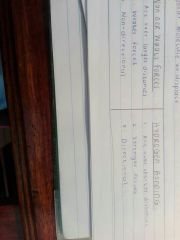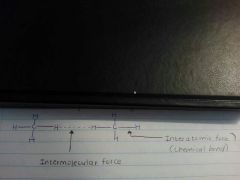![]()
![]()
![]()
Use LEFT and RIGHT arrow keys to navigate between flashcards;
Use UP and DOWN arrow keys to flip the card;
H to show hint;
A reads text to speech;
20 Cards in this Set
- Front
- Back
|
Explain induced dipole-induced dipole forces. |
They are forces between non-polar molecules. |
|
|
Explain dipole-dipole forces. |
They are forces between polar molecules. |
|
|
Explain dipole-induced dipole forces. |
They are forces between polar and non-polar molecules. |
|
|
Briefly explain hydrogen bonding. |
Hydrogen bonding refers to the forces between molecules in which hydrogen is covalently bonded to nitrogen, oxygen or fluorine. It is a special case of dipole-dipole forces. |
|
|
Give 3 other names for induced dipole-induced dipole forces. |
London forces Dispersive forces Mutually induced dipole forces |
|
|
How are temporary/induced dipoles formed? |
The electron cloud in one polar molecule is temporarily displaced to one side. The ends of this moleculle will have small charges, and displace electron clouds of adjacent molecules. |
|
|
Name 3 differences between Van der Waals Forces and hydrogen bonding. |

|
|
|
What are the two conditions for hydrogen bonding to occur? |
Hydrogen must be bonded to a 1) small and 2) highly electronegative atom. |
|
|
Which three elements result in hydrogen bonding when bonded to a hydrogen atom? |
Oxygen in H2O Nitrogen in NH3 Fluorine in HF |
|
|
Why is hydrogen bonding such a strong intermolecular force? |
A large difference in electronegativity results in a significant positive charge on the hydrogen atom. This significant positive charge strongly attracts the highly negative pole (O/N/F) of the adjacent molecule, resulting in a strong intermolecular force. Hydrogen atoms are very small, so the adjacent molecules can approach the original molecule very closely, resulting in a very strong intermolecular force. |
|
|
Why is the boiling point of H2S less that the boiling point of H2O? |
H2O has hydrogen bonding and H2S has dipole-dipole forces. Hydrogen bonding is stronger then dipole-dipole forces, so it takes more energy to break the hydrogen bonding and cause water to boil. |
|
|
What is the difference between intermolecular and interatomic forces? |
Intermolecular forces exist between molecular units, whereas interatomic forces exist between atoms in chemical compounds. |
|
|
Show the difference between intermolecular and interatomic forces in a diagram. |

|
|
|
Define: boiling point |
The temperature at which the vapour pressure of a substance equals atmospheric pressure. |
|
|
What is the relationship between intermolecular forces and boiling point? |
The stronger the intermolecular forces, the higher the boiling point. |
|
|
Define: melting point |
The temperature at which the solid and liquid phases of a substance are at equilibrium. |
|
|
Describe the relationship between intermolecular forces and melting point. |
The stronger the intermolecular forces, the higher the melting point. |
|
|
Define: vapour pressure |
The pressure exerted by a vapour at equilibrium with its liquid in a closed system. |
|
|
State the relationship between intermolecular forces and vapour pressure. |
The stronger the intermolecular forces, the lower the vapour pressure. |
|
|
Define: solubility |
The property of a solid, liquid or gaseous chemical substance (solute) to dissolve in a solid, liquid or gaseous solvent to form a homogeneous solution. |

